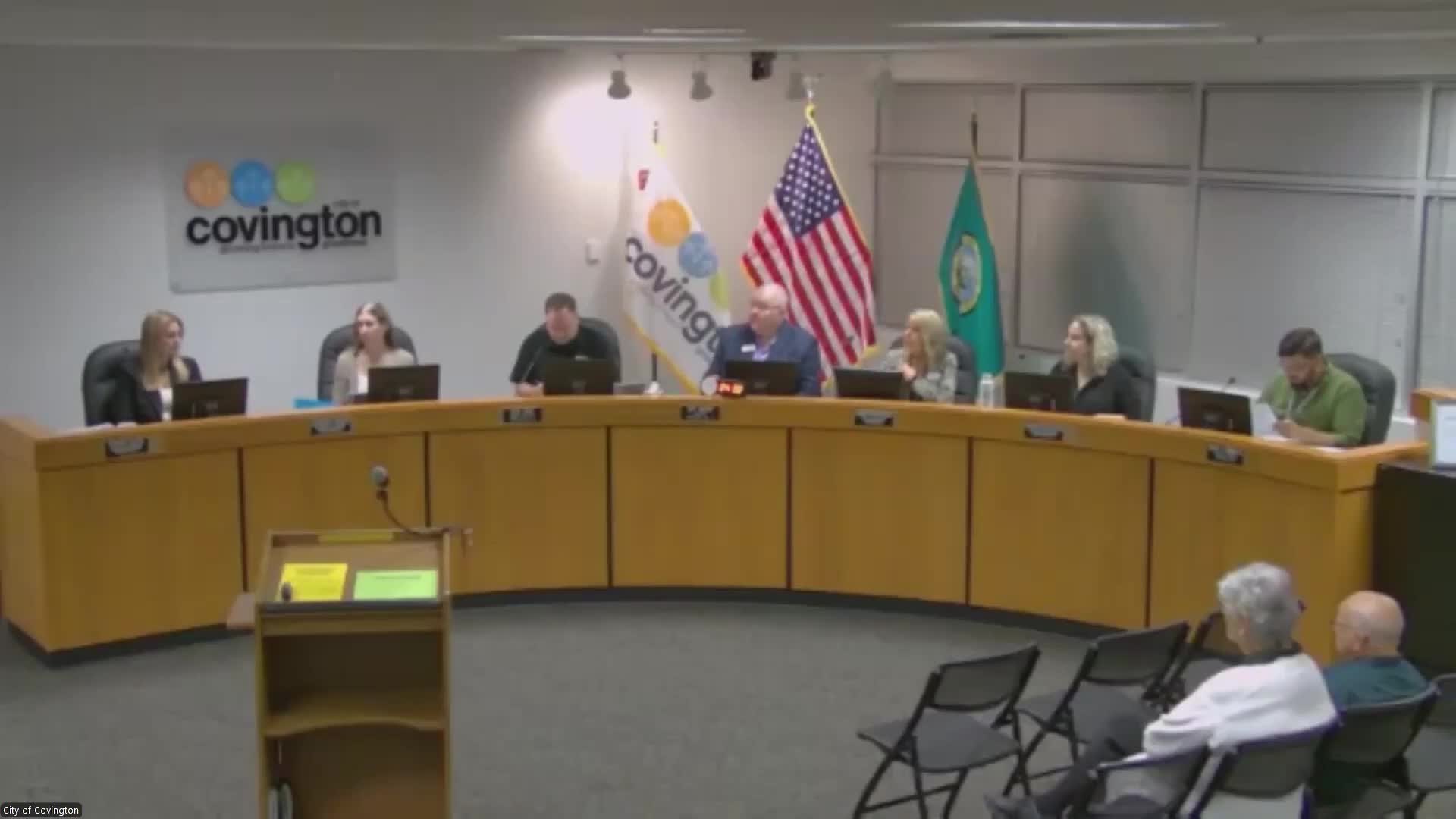Covington council adopts 6% annual surface‑water management rate increase, to be reevaluated within three years
November 01, 2025 | Covington, King County, Washington
This article was created by AI summarizing key points discussed. AI makes mistakes, so for full details and context, please refer to the video of the full meeting. Please report any errors so we can fix them. Report an error »

The Covington City Council on Tuesday approved a 6% annual increase to the city’s surface‑water management (SWIM) rate beginning in 2026 and asked staff to return within three years to reevaluate the forecast and regulatory outlook.
Council adopted the rate after a staff presentation that described regulatory and maintenance pressures on the fund, including National Pollutant Discharge Elimination System (NPDES) requirements, the stormwater management action plan (SMAP) subbasins, increasing contract and construction costs, and a growing inventory of public stormwater infrastructure from recent development. Staff presented a six‑year forecast showing that, without rate increases, the fund would run operating deficits and that reserves could drop from about $4.8 million in 2026 to $1.6 million by 2031 under the example scenarios.
Public‑works staff Don and Ben explained that routine tasks—catch‑basin cleaning, filter‑vault servicing, pond 'muck' rehabilitation, retrofits to remove untreated outfalls, and compliance programs tied to the SMAP—have become more expensive and, in many cases, more frequent under current permit cycles. “These pieces now…are kind of the foundation of what our proposed rate adjustments are,” Ben said, describing recurring maintenance, permit‑driven capital projects, and the need to avoid backsliding on system performance.
Staff recommended a 6.5% annual increase as the working proposal; during council discussion some members proposed lower rates (5% or 6%). Council settled on 6% as a compromise balancing long‑term reserves and rate pressure on residents. Councilmember Joe moved adoption of the 6% schedule and the motion carried after a second; the ordinance/resolution will implement the increases on the 2026 tax roll and requires staff to return for review within three years.
What the increase means: the city collects SWIM as a property‑tax assessment (flat single‑family charge and different commercial rates). Staff presented the current average single‑family residential SWIM charge of approximately $369.66 annually and modeled how rate steps would affect ending cash balances and reserves through 2031. Staff noted some capital projects may be eligible for grants but cannot be counted on to eliminate the need for rate revenue.
Why it matters: stormwater operations are a long‑term, regulatory obligation for the city. Council adopted a multi‑year approach to smooth rate increases while preserving a reserve cushion; staff will return sooner if significant new permit requirements or development revenues change the fiscal picture.
What’s next: staff will implement the rate increase beginning in 2026 and schedule a formal reevaluation of the SWIM fund and forecast within three years, earlier if new NPDES/SMAP requirements or major grant awards change revenue needs.
Council adopted the rate after a staff presentation that described regulatory and maintenance pressures on the fund, including National Pollutant Discharge Elimination System (NPDES) requirements, the stormwater management action plan (SMAP) subbasins, increasing contract and construction costs, and a growing inventory of public stormwater infrastructure from recent development. Staff presented a six‑year forecast showing that, without rate increases, the fund would run operating deficits and that reserves could drop from about $4.8 million in 2026 to $1.6 million by 2031 under the example scenarios.
Public‑works staff Don and Ben explained that routine tasks—catch‑basin cleaning, filter‑vault servicing, pond 'muck' rehabilitation, retrofits to remove untreated outfalls, and compliance programs tied to the SMAP—have become more expensive and, in many cases, more frequent under current permit cycles. “These pieces now…are kind of the foundation of what our proposed rate adjustments are,” Ben said, describing recurring maintenance, permit‑driven capital projects, and the need to avoid backsliding on system performance.
Staff recommended a 6.5% annual increase as the working proposal; during council discussion some members proposed lower rates (5% or 6%). Council settled on 6% as a compromise balancing long‑term reserves and rate pressure on residents. Councilmember Joe moved adoption of the 6% schedule and the motion carried after a second; the ordinance/resolution will implement the increases on the 2026 tax roll and requires staff to return for review within three years.
What the increase means: the city collects SWIM as a property‑tax assessment (flat single‑family charge and different commercial rates). Staff presented the current average single‑family residential SWIM charge of approximately $369.66 annually and modeled how rate steps would affect ending cash balances and reserves through 2031. Staff noted some capital projects may be eligible for grants but cannot be counted on to eliminate the need for rate revenue.
Why it matters: stormwater operations are a long‑term, regulatory obligation for the city. Council adopted a multi‑year approach to smooth rate increases while preserving a reserve cushion; staff will return sooner if significant new permit requirements or development revenues change the fiscal picture.
What’s next: staff will implement the rate increase beginning in 2026 and schedule a formal reevaluation of the SWIM fund and forecast within three years, earlier if new NPDES/SMAP requirements or major grant awards change revenue needs.
Don't Miss a Word: See the Full Meeting!
Go beyond summaries. Unlock every video, transcript, and key insight with a Founder Membership.
✓
Get instant access to full meeting videos
✓
Search and clip any phrase from complete transcripts
✓
Receive AI-powered summaries & custom alerts
✓
Enjoy lifetime, unrestricted access to government data
30-day money-back guarantee

